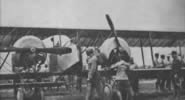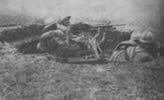When Bulgaria declared war on Romania on the 18th of August, the situation inside Dobrogea was the following : the Romanian 17th Infantry Division defended the Turtucaia bridgehead ; the 9th defended the Silistra bridgehead ; the 19th Infantry Division plus the 5th Calarasi Brigade stationed in the Bazargic area. The 24th Russian Corps was still forming up in the Cernavoda area, though it was supposed to be ready by now. Altogether, the combined Romanian and Russian forces had 83 battalions, 35 cavalry squadrons and 75 batteries ( 40 of them were however fixed batteries of limited value and there was not a single heavy artillery piece in all of Dobrogea ). Their main opponent was the 3rd Bulgarian army, made up of 3 Bulgarian infantry divisions, one Bulgarian cavalry division and several other units, including a German infantry brigade. The Central Powers had massed 62 battalions, 25 cavalry squadrons and 55 batteries, including 9 heavy batteries equipped with modern German guns. Taking a look at the numbers, it might look like the Romanian and Russian forces slightly outnumbered the Bulgarians. On paper, they did, but it must be taken into consideration that two of the Romanian divisions ( the 17th and the 19th ) were newly raised units, made up of elderly reserve troops, that they were short of officers and NCO's, that much of their artillery was fixed and therefore could not be redeployed to reinforce other sectors, and that it was difficult to supply the bridgeheads since there was no bridge over the Danube. Furthermore, not all of the Russian troops had arrived, which meant that superiority was actually on the side of the 3rd Bulgarian Army, which was made up of the best divisions Bulgaria could muster and could expect to receive more German and Turkish reinforcements soon. As Turtucaia and Silistra were fairly far away, there was a serious danger that the Romanian divisions could be defeated separately, one by one. Realizing that it had local superiority, the German commander of all Central Powers's forces in Dobrogea, field marshal von Mackensen, decided to attack the city of Turtucaia and the 17th Infantry Division. For this purpose, he used most of the 3rd Army's forces ( 27 battalions and 37 batteries, 8 of which were heavy ) , leaving only a couple of infantry brigades to cover its right flank. During the neutrality period, the Turtucaia "bridgehead" had been somewhat reinforced . There were two horseshoe-shaped "resistance lines", preceded by a number of outposts, with their backs to the Danube. The main defensive line was situated on the dominating heights south and west of the city, 4 to 7 kilometers of its outskirts. It consisted of 15 strongpoints built from wood and earth, connected by a network of trenches and protected by obstacles and barbed wire. About 4 kilometers behind the main line, there was a second position, consisting of a single, narrow trench. The outposts were situated 1 to 3 kilometers in front of the main line. The entire system of fortifications was inspired by those of 1877 war and it did provide reasonably good protection against small-arms fire and light artillery. However, against the heavy German guns it could not hold out too long, and it lacked depth, which decreased its value. Considering that much of the existing artillery was fixed and light, it's easy to understand how the Bulgarians achieved a crushing superiority in the attack sectors : 6/1 in infantry and 12/1 in artillery.
|









